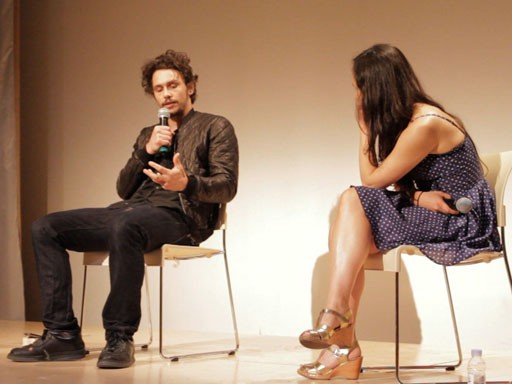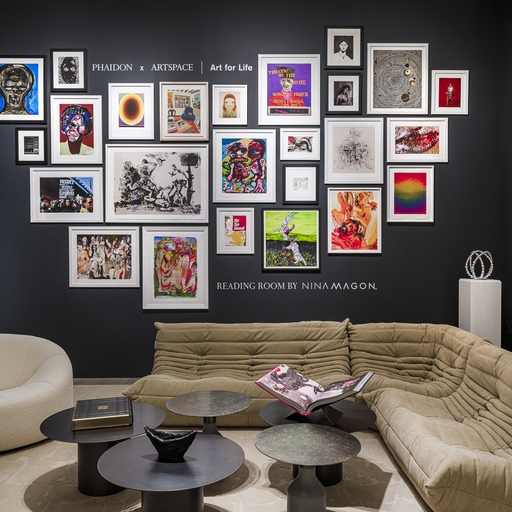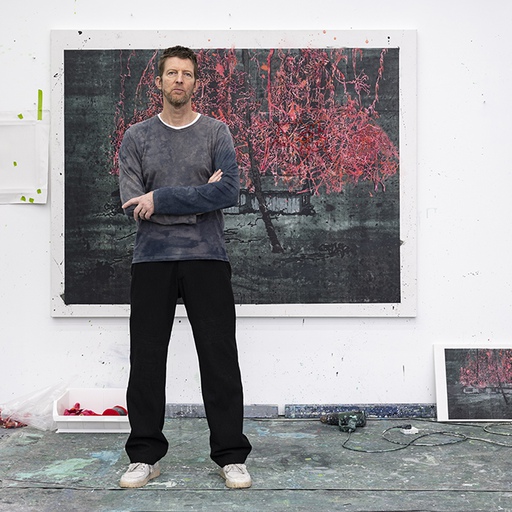On Saturday, James Franco joined with Artspace and The Thing Quarterly to host a screening of his new film, Brad, at the New Museum and debut his new limited-edition artwork: a switchblade emblazoned with the words "Brad Renfro Forever." The artwork, which is available on Artspace, relates rather incisively to the film. A twisted homage to the late actor and bad-boy heartthrob Brad Renfro, who died of a heroin overdose in 2008 at the age of 25, Brad shows Franco memorializing his onetime peer by having a tattoo artist carve "Brad" in his arm with a switchblade—an excruciating process that both recalls the weapon of choice in Rebel Without a Cause, the most famous film of Franco's adopted Hollywood icon, James Dean, and also calls up thoughts of endurance-based performance artworks by Marina Abramovic and Chris Burden. After screening the film, Franco sat down for a talk with fellow artist and collaborator Laurel Nakadate, who previously temed up with Franco for a 2011 Performa commission. What follows is a lightly edited and condensed transcript of their conversation.
FRANCO: A year and a half ago I remember John approached me about doing an edition for The Thing and we started talking about ideas, and around that time I began thinking about Brad a lot—I guess he died about four years ago now. And I'd done two movies with him, I did a really bad movie called Deuces Wild and a short film called The Car Kid. It got me thinking, when I paired it up with The Thing, maybe it was an opportunity to do something with Brad. So, the movie Deuces Wild was this movie directed by the guy who directed The Basketball Diaries with Leonardo DiCaprio and Mark Wahlberg, which had been a really cool film when I was young, and definitely Jim Carroll was an influence. So it was this film about the '50s and about rumbles and knives and all that stuff, and for every young actor in Hollywood it felt like, "Oh, this is the new Mean Streets." And there was a role in there that was kind of like the new Johnny Boy, like DeNiro's role in Mean Streets, and everybody wanted it, including me. And I went and auditioned, but I hadn't really done much by that point—I'd done my Pacific Blues TV show and other things. But I think I killed the audition…. But anyway, Brad was cast in the role, and I remember seeing him and just thinking, "What?" He was having a hard time at that point and anyway everybody had high expectations for the film. It was shot and the DP was John Alonzo who had shot Chinatown and Scarface—it ended up being his last film, sadly—and it had all these actors, you know, three actors from The Sopranos and Matt Dillon and all these people. So there were all these high expectations, which is horrible because it was just a horrible movie, and it kind of showed me that there was something so sad about that—to me captured the tragedy that being an actor can be. You put so much into something and you have such high expectations and ultimately it's out of your hands. And so to me it sort of became also a metaphor for people that also don't have control over their lives, so I took the switchblade motif from that film. It's something that's both violent and that has something underlying it that's the opposite of that, something very tender. I feel like remembering Brad needed something this strong, because in my mind he was so violently forgotten. One of the other things that kicked it off is he wasn't mentioned at the Oscars the year that he died. So I took the switchblade idea and I took it one step farther.
NAKADATE: I feel blindsided because I hadn't seen that until just now and I sort of feel like I just watched something that I don't really want to talk about. Not because it wasn't profound, but because it was profound. I really loved it first of all, happily loved it. It was very, very upsetting actually. One thought that I'd like you to finish is that conversation of celebrity and the darkness and the way celebrity is consumed.
FRANCO: This relates to some projects that I've done. Gus Van Sant gave me all the raw material of River Phoenix in My Own Private Idaho, which I think was River's best performance, and he died two years after that was filmed, and so I ended up cutting that together into a new version of that film. So I'm very aware that the subjects I'm dealing with are very sensitive material, and one side of me thinks like maybe you should just leave it alone—I don't want to disrespect them in any way. But another side of me thinks that one thing that happens when an actor or anyone in the public eye dies is that the family understandably doesn't want to talk [to the press] because so much weird attention is put on the situation—tabloid attention. So what that means is that sometimes the last word is what the tabloids write, or a photo on the cover of People magazine. I felt that some of these projects were just a way to tell the story one more time, but with love and respect and a different kind of understanding. And with this project, you know, it was weird because I because I felt like it had such a big impact on me—it was such a slap that he didn't get mentioned at the Oscars. I know in some ways it's not that big of a thing, but it was his business—it's what he gave his life to. So this project turned into a billboard that we put up on Sunset Boulevard. It's a billboard that Gucci owns, and it wasn't easy but I worked it out so this image could be up there and it wasn't selling clothes or anything but it was an outlet to say, okay, he wasn't mentioned in the Oscars, but I'm gonna put him up on Sunset and make you remember. I guess what I'm saying is the way that these projects are framed is also kind of remembrance.
NAKADATE: So did anybody comment on the billboard? Was there any sort of reaction like, "Oh no, we forget him and this is some sort of memorial or eulogy"?
FRANCO: No. I mean, I don't know who made the decision that way that he should not be mentioned. Maybe they were running long that night, I don't know. I mean, there's nobody that I'm really after. It's more about my feeling as an actor that you give a lot, give a lot, give a lot, and then there's the new trend and people are forgotten. I don't know if my project is really to make a difference in that trend, but I think that just the effort of working against that is something—that the effort is enough.
NAKADATE: Something that really struck me about the video is the simplicity of it. It succeeded in ways that it shouldn't have on paper, you know?
FRANCO: Yeah. It kind of relates to some of the stuff that you and I have been doing. That was really the last house that he kind of lived in.
NAKADATE: Was that his bedroom?
FRANCO: That was his bedroom that we did it in. I brought in this tattoo guy, Mark Mahoney, to do it and he so cool he makes you want to get 20 tattoos. But I also brought some people over who had known Brad at the end, and there was one who sadly found it to be too much for him, I think he was battling drugs himself, and that night he freaked out and ran out of the house to go use or something. I guess it was a charged atmosphere. But the idea was just to go and to do it there, and it was a kind of acting that was different than the acting that I normally do. Like I acted like my arm was being cut off in 127 Hours, I acted that pain. But when you have something that's actually enacted upon you, physically upon you, it's a different kind of movie that results. That kind of performance or result is so different—it's grounded in a different way.
NAKADATE: And I feel like the stakes were really different here. I feel like there was this joy that was really unexpected actually, this joy on your face—that smile—while it was happening, you know. It was almost I feel like it was happy tears at that moment he was cutting into you.
FRANCO: Yeah, I was like almost passing out, so I had to do something. [laughs]
NAKADATE: You looked really joyful and you seemed to be really enjoying it.
FRANCO: I was trying to relax.
NAKADATE:This is not the first time you've worked with a dead person or a person who had a great and gifted life and then went to the other side. Do you want to talk a little bit about Hart Crane or the other people you have explored through your artwork?
FRANCO: Yeah, I mean, you and I just did a project in New Orleans with the late photographer Auguste Belloc who shot erotic photos of women from the early 1900s. We went into his house in a similar way and we recreated some of the photos where he shot them. And then it will sound a little weird—it should be a little weird—but we got a practicing voodoo… what is he called, a priest?
NAKADATE: I think he called himself a professor. I was actually struck by how polite you were. You walked right up to him and were like, "Hello, Professor." And I thought: this is what separates the professionals from the video artists, because you were so cool and collected and I was just like, "Hey, man…." So it was like really an honor the way that you handled that. But do you want to tell them what happened?
FRANCO: I guess the idea was just to make an effort at this eerie gesture, whether the guy made contact with Belloc or not—just the idea of reaching and making a connection between now and a hundred years ago. So it was about going through a series of steps, going to his grave, doing the series of photos in his place, and then going to the voodoo guy. Whether his spirit was around or not I don't know, but certainly I think it was sort of in us at that moment just because we were going through these sort of actions.
NAKADATE: I think there was something really powerful actually about going through that home and being on that site and in that space together. I remember we were standing on the second floor walking to that spot of the iconic photo of the girl in the stripes was taken and standing in that spot and feeling like something's happening here. And I agree, I see the project in many ways as putting in this love and attention and energy to go to all of these places and really caring about where we find ourselves and the people that we have these conversations with, trying to connect with them. I guess that's something you have done with Allen Ginsberg or any of these characters that you've inhabited—they just feel like such loving performances, of trying to walk through these steps and these places that they've gone. So this film for me really tied together a lot of things in your practice. I think that something I really admire is how I feel like you're always working, in the best way possible. And another thing I've noticed is you always have a book you're always reading. Do you have any other weird things that you do to keep yourself company on the road? For example—I'll embarrass myself—I cried every day of 2010 to keep myself comfortable as I traveled around. Is there anything weird you do like that?
FRANCO: Yeah. I travel around a lot, and I sleep on couches because foreign bedrooms feel lonely. And I draw on the iPad now, so I bring that around and draw on that. And whenever I leave the house I have a book.
NAKADATE: Alright we're going to open this up to the audience for questions. Come on people!
AUDIENCE MEMBER: Is "Brad" still carved in your arm? How long did the carving last?
FRANCO: How long did the carving last? It's still there, but it's pretty light. I thought it would last a lot longer.
NAKADATE: So you didn't go deep? You did the girl-cutter version? [laughs] I noticed you never gave him any signal to stop.
FRANCO: I didn't tell him to hold back at all. But, like, after the A or in the middle of the A I had to take a real break. But I wish he'd gone deeper because it's kind of faded away.
AUDIENCE MEMBER: What was the idea behind the white T-shirts that the tattoo artist kept using to dab away your blood? What did you do with them?
FRANCO: We were going to have this whole kind of crazy presentation that we were going to do with the knives. They become part of this other project that is at the Museum of Contemporary Art in L.A., and I originally intended to show some of the T-shirts as well. Actually, this is what we were gonna do: we were going to wrap the blades in the T-shirts and hand them out that way, kind of like a '50s James Dean, white-T-shirt thing. And then there was going to be a limited-edition one with blood on it, but I guess that didn't happen. There were big thoughts.
AUDIENCE MEMBER: When you co-hosted the Oscars you got a lot of criticism. Can you talk about your performance at the Oscars?
FRANCO: That's a whole other thing, but it kind of ties in. I watched it afterwards, and I won't say that I thought it was a great version of the Oscars. But I also, you know… anybody's who's in show business knows that actors are only one part of the equation. There are hundreds of people that work on that show. I might have looked like I wasn't into some of the lines that I had to say, but that's partly because I wasn't [laughs]. But it was also that there's a certain dynamic that you have on stage. I've learned in comedy on stage that there has to be a straight man and a wacky one—sort of a high-energy role—so I took the low-energy role. You know, it is what it is. I never ever dreamed that I wanted to be, like, a great Oscar host—that was never a goal of mine—so when they asked me to do it I really just signed on and thought, "This will be an experience and they can kind of use me as they want. I don't need to put my mark on this, I'll just do as well as I can." Sort of in the same way that I thought about General Hospital. When I went on General Hospital, I didn't want to go and change it or say, "I don't want to do this melodramatic line," or anything. I just wanted to do it the way that they do it, and when I did that with General Hospital people thought that was kind of crazy and wild and cool. When I did it with the Oscars…. People are very hypocritical about the Oscars—everybody criticizes them before they happen. Everyone says, "It's gonna be too long, it's gonna be boring, it's a horrible show. Why would we watch it?" And then when I went on it was like an opportunity to go after me. But I feel like it was partly insincere criticism because I don't think that a lot of people who went after me really care about the host of the Oscars—they just wanted to go after me.
AUDIENCE MEMBER: So, how can anyone see your River Phoenix movie? Is there a plan to show it somewhere?
FRANCO: Yeah, the My Own Private Idaho footage is a project that is now called My Own Private River because it's a feature-length movie, about 90 minutes, and it focuses mainly on River's character. And that's a tricky project too because obviously the studio doesn't want us to sell it and take their sales from My Own Private Idaho, but we were given it—it was a gift that I was allowed to do it and show it. But we've been showing it around. We showed it at PS1 here, then at Lincoln Center and in L.A., and we showed it in Munich. But I know a lot of people want to see it and it's pretty good. And Gus really likes it too—otherwise he wouldn't have let me show it to people. So a lot have people have asked me about it so I'm trying to figure out ways to show it more.
In DepthJames Franco on His Painful "Brad" Switchblade Performance
























